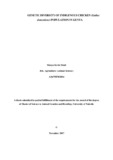| dc.description.abstract | This study was conducted with the aim of analyzing the diversity, relationship and population structure of the local indigenous chicken ecotypes in Kenya at the genetic level. Ecotypes from different regions were compared to identify regions which have been subjected to selection (selection signatures). A total of 384 free-ranging chicken sampled from eight counties in four geograpical regions (Western, North Rift, South Rift and Coast) in Kenya were genotyped using 12 microsatellite markers. Identification of signatures of selection was done using whole genome-resequencing data. The total number of alleles for all codominant data was 140, while the mean number of different alleles (NA) was 8.094 ± 0.516 and the effective number of alleles (NE) 4.452 ± 0.297. Observed (HO) and expected (HE) heterozygosities were 0.714 ± 0.011 and 0.726 ± 0.009 respectively for the whole population. The fixation indices – effects of sub-populations to the total population (FST), variance among subpopulations within groups (FIS), and variance among groups relative to total variance (FIT) for all populations were 0.029, 0.066 and 0.093 respectively. A total of 21 private alleles were observed in all populations. Bomet and West-Pokot ecotypes were closely related (0.997) than the rest of the population while the most distantly related were Lamu and Narok (0.779). The studied chicken population showed two clusters at K=8 when analyzed using STRUCTURE software. On identifying selection signatures, a total of 36,026 SNP variants were identified in these chicken populations with 30 Z-transformed outlier values ranging between 5 and 8 all in the 8th chromosome. Ninety nine percent (99%) of the variants were modifiers. Of the total biotype, 50.96 were in the non-coding region, 26.22 in the protein coding region. The consequences were expressed in upstream and downstream regions of the DNA, intron, intron non-coding transcript region and intergenic regions. The study concluded that with this rich genetic diversity, management and conservation measures should be undertaken for sustainable utilization of the indigenous chicken and reduce genetic dilution. | en_US |



